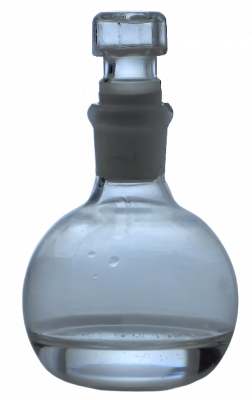Hydrazine Hydrate
Hydrazine hydrate is represented as H4 N2 . x H2 O. It is a colorless, flammable liquid with an ammonia-like odor. Pure anhydrous hydrazine was first prepared by the Dutch chemist Lobry de Bruyn in 1895. Hydrazine hydrate is toxic and must be handled with extreme care.


- Overview
- Application
- Spesification
Overview
Hydrazine is the chemical compound with formula N2H4. It is widely used in chemical synthesis and is a component in some rocket fuels. With an ammonia-like odor, hydrazine has a liquid range and density similar to water.
MOLECULAR STRUCTURE AND PROPERTIES
Conceptually, hydrazine arises via coupling a pair of ammonia molecules by removal of one hydrogen per molecule. Each H2N-N subunit is pyramidal. The N-N distance is 1.45 Å, and the molecule adopts a gauche conformation. The rotational barrier is twice that of ethane. These structural properties resemble that of gaseous hydrogen peroxide, which adopts a “skewed” anticlinal conformation, and also experiences a strong rotational barrier.
It has basic properties comparable to ammonia but 15-times weaker.
N2H4 + H+ → [N2H5]+ K = 8.5 x 10-7
(for ammonia K = 1.78 x 10-5 It can be diprotonated only with difficulty:
[N2H5]+ + H+ → [N2H6]2+ K = 8.4 x 10-16
SYNTHESIS
Theodor Curtius synthesized free hydrazine for the first time in 1889 via a circuitous route. Hydrazine is produced in the Olin Raschig process from sodium hypochlorite and ammonia, a process announced in 1907. This method relies on the reaction of chloramine with ammonia.
Hydrazine can also be produced via the so-called ketazine and peroxide processes. In 2001, Microbiologist Marc Strous from the University of Nijmegen in the Netherlands discovered that hydrazine is produced from the yeast bacteria and open ocean bacteria anammox (Brocadia anammoxidans). They are the only discovered organism to naturally produce hydrazine, which is used in rocket fuels.
Application
USES IN CHEMISTRY
Hydrazines are part of many organic syntheses, often those of practical significance in pharmaceuticals, such as antituberculants, as well as in textile dyes and in photography.
WOLFF-KISHNER REDUCTION
Hydrazine is used in the Wolff-Kishner reduction, a reaction that transforms the carbonyl group of a ketone or aldehyde into a methylene (or methyl) group via a hydrazone intermediate. The production of the highly stable dinitrogen from the hydrazine derivative helps to drive the reaction.
HETEROCYCLIC CHEMISTRY
Being bifunctional, with two amines, hydrazine is a key building block for the preparation of many heterocyclic compounds via condensation with a range of difunctional electrophiles. With 2,4-pentanedione, it condenses to give the dimethylpyrazole. In the Einhorn-Brunner reaction hydrazines react with imides to give triazoles.
REDUCING AGENT
Hydrazine is a convenient reductant because the by-products are typically nitrogen gas and water. Thus, it is used as an antioxidant, an oxygen scavenger, and a corrosion inhibitor in water boilers and heating systems. It is also used to reduce metal salts and oxides to the pure metals in electroless nickel plating and plutonium extraction from nuclear reactor waste.
OTHER INDUSTRIAL USES
Hydrazine is used in many processes including: production of spandex fibers, as a polymerization catalyst; a blowing agent; in fuel cells, solder, fluxes; and photographic developers, as a chain extender in urethane polymerizations, and heat stabilizers. In addition, a semiconductor deposition technique using hydrazine has recently been demonstrated, with possible application to the manufacture of thin-film transistors used in liquid crystal displays. Hydrazine in a 70% hydrazine, 30% water solution is used to power the EPU (emergency power unit) on the F-16 fighter plane. The explosive Astrolite is made by combining hydrazine with ammonium nitrate.
Spesification
| PRODUCT IDENTIFICATION | |
| CAS NO. | 302-01-2 (Base), 7803-57-8 (Hydrate) |
| EINECS NO. | 206-114-9 |
| FORMULA | H2NNH2.H2O |
| MOL WT. | 50.06 |
H.S. CODE | 2825.10 |
| TOXICITY | Oral rat LD50: 129 mg/kg |
| SYNONYMS | Hydrazine, monohydrate; Hidrazina (Spanish); Hydrazine hydroxide; Hydrazinium hydroxide; Idrazina idrata (Italian); |
| DERIVATION | ammonia with chloramine or sodium hypochlorite with urea |
| PHYSICAL AND CHEMICAL PROPERTIES (N2H4 64%) | |
| PHYSICAL STATE | clear liquid |
| MELTING POINT | -51 C |
| BOILING POINT | 118 C |
| SPECIFIC GRAVITY | 1.032 |
| SOLUBILITY IN WATER | Miscible |
| pH | Strong Base |
| VAPOR DENSITY | 1.73 |
AUTOIGNITION | 280 C |
NFPA RATINGS | Health: 3; Flammability: 3; Reactivity: 3 |
REFRACTIVE INDEX | 1.4280 |
| FLASH POINT | 74 C |
| STABILITY | Stable under ordinary conditions |
| SALES SPECIFICATION | |
APPEARANCE | clear liquid |
HYDRATE (HYDRAZINE) | 55% 75% 85% 100% (35.2% 48.0% 54.4% 64%) |
CHLORIDE | 0.001% max |
SULFATE | 0.0005% max |
IRON | 5ppm max |
NON VOLATILES | 0.01% max |
HEAVY METALS | 5ppm max |





